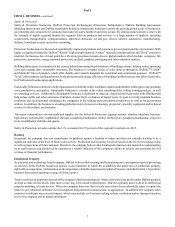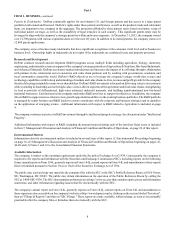DuPont 2015 Annual Report Download - page 13
Download and view the complete annual report
Please find page 13 of the 2015 DuPont annual report below. You can navigate through the pages in the report by either clicking on the pages listed below, or by using the keyword search tool below to find specific information within the annual report.Part I
ITEM 1A. RISK FACTORS, continued
12
In addition, the Merger Agreement restricts each of DuPont and Dow, without the consent of the other party, from making certain
acquisitions and divestitures, entering into certain contracts, incurring certain indebtedness and expenditures, paying dividends
in excess of certain thresholds, repurchasing or issuing securities outside of existing share repurchase and equity award programs,
and taking other specified actions until the earlier of the completion of the mergers or the termination of the merger agreement.
These restrictions may prevent or delay pursuit of strategic corporate or business opportunities that may arise prior to the
consummation of the Mergers. Adverse effects arising during the pendency of the Mergers could be exacerbated by any delays in
consummation of the Mergers or termination of the Merger Agreement.
DuPont expects to incur substantial transaction-related costs in the connection with the Mergers.
DuPont expects to incur significant costs, expenses and fees for professional services and other transaction costs in connection
with the transaction. The substantial majority of these costs will be non-recurring expenses relating to the Mergers and the intended
Business Separations, including costs relating to integration and separation planning. These costs could adversely affect the
financial condition and results of operation of DuPont prior to the Mergers and of the combined company following the Mergers.
Risks Related to the Company’s Operations
The company's operations could be affected by various risks, many of which are beyond its control. Based on current information,
the company believes that the following identifies the most significant risk factors that could affect its businesses. Past financial
performance may not be a reliable indicator of future performance and historical trends should not be used to anticipate results or
trends in future periods.
The company’s operations outside the United States are subject to risks and restrictions, which could negatively affect our
results of operations, financial condition, and cash flows.
The company’s operations outside the United States are subject to risks and restrictions, including fluctuations in currency values
and foreign-currency exchange rates; exchange control regulations; changes in local political or economic conditions; import and
trade restrictions; import or export licensing requirements and trade policy and other potentially detrimental domestic and foreign
governmental practices or policies affecting U.S. companies doing business abroad. Although DuPont has operations throughout
the world, sales outside the U.S. in 2015 were principally to customers in Eurozone countries, China, Brazil, and Japan. Further,
the company’s largest currency exposures are the European Euro, Brazilian Real, the Chinese Yuan, and the Japanese Yen. Market
uncertainty or an economic downturn in these geographic areas could reduce demand for the company’s products and result in
decreased sales volume, which could have a negative impact on DuPont’s results of operations. In addition, changes in exchange
rates may affect the company’s results from operations, financial condition and cash flows in future periods. The company actively
manages currency exposures that are associated with net monetary asset positions, committed currency purchases and sales, foreign
currency-denominated revenues and other assets and liabilities created in the normal course of business.
Volatility in energy and raw materials costs could have a significant impact on the company's sales and earnings.
The company's manufacturing processes consume significant amounts of energy and raw materials, the costs of which are subject
to worldwide supply and demand as well as other factors beyond the control of the company. Significant variations in the cost of
energy, which primarily reflect market prices for oil, natural gas, and raw materials affect the company's operating results from
period to period. Legislation to address climate change by reducing greenhouse gas emissions and establishing a price on carbon
could create increases in energy costs and price volatility.
When possible, the company purchases raw materials through negotiated long-term contracts to minimize the impact of price
fluctuations. Additionally, the company enters into over-the-counter and exchange traded derivative commodity instruments to
hedge its exposure to price fluctuations on certain raw material purchases. The company takes actions to offset the effects of higher
energy and raw material costs through selling price increases, productivity improvements and cost reduction programs. Success
in offsetting higher raw material costs with price increases is largely influenced by competitive and economic conditions and could
vary significantly depending on the market served. If the company is not able to fully offset the effects of higher energy and raw
material costs, it could have a significant impact on the company's financial results.
























